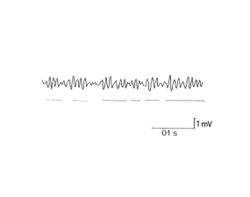Philosophy:Ocular tremor
Ocular tremor (ocular microtremor) is a constant, involuntary eye tremor of a low amplitude and high frequency. It is a type of fixational eye movement that occurs in all normal people, even when the eye appears still.[1] The frequency of ocular microtremor has been found to range from 30 Hz to 103 Hz, and the amplitude is approximately four thousandths of a degree.[1][2]
Cause
Human eyes are constantly moving, even if they appear to be focused on an object.[1] These constant oscillations are called fixational eye movements, and they include ocular microtremor, microsaccades, and drift.[1][3] Ocular tremor is the smallest of these movements, and it often overlaps with drift.[1][3] This makes it the most difficult fixational eye movement to measure.[1][3] Due to these difficulties in measurement, fewer studies have been performed on ocular microtremor,[1][3] leading to the phenomenon of ocular tremor not being well-understood.[1][3]
Researchers are not entirely sure of the cause of ocular microtremor.[1] It may be a result from the firing of motor neurons at different times.[1][4] It has also been suggested that ocular tremor is a result of the eye being balanced between opposing muscles.[1]
Size and measurement
Ocular microtremor is smaller than the other fixational eye movements of microsaccades and drift.[1][3] It occurs between microsaccades, during the same time intervals as drift.[1][3] The measured frequency and amplitude of ocular tremor have been found to vary.[1][2][3] The frequency typically falls between 30 Hz and 103 Hz, while the amplitude has been measured to be approximately four thousandths of a degree.[3][1][2]
Specific tools, known as piezoelectric probes or piezoelectric strain gauges, are commonly used to measure ocular microtremor.[1] A local anesthetic is used for both of these invasive methods, because contact with the sclera is required.[1] While non-contact methods of measuring ocular tremor have been found, they are not typically used due to their low resolution.[1]
See also
- Eye movements
- Fixational eye movements
- Human eye
- Visual perception
- Piezoelectric sensor
References
- ↑ 1.00 1.01 1.02 1.03 1.04 1.05 1.06 1.07 1.08 1.09 1.10 1.11 1.12 1.13 1.14 1.15 1.16 1.17 "Fixational Eye Movements" (in en). Eye Movement Research: An Introduction to its Scientific Foundations and Applications. Studies in Neuroscience, Psychology and Behavioral Economics. Cham: Springer International Publishing. 2019. pp. 73–115. doi:10.1007/978-3-030-20085-5_3. ISBN 978-3-030-20085-5.
- ↑ 2.0 2.1 2.2 "Fixation Movements of the Eyes" (in en). The Brain and Regulation of Eye Movement. Boston, MA: Springer US. 1977. pp. 23–66. doi:10.1007/978-1-4684-6964-6_2. ISBN 978-1-4684-6966-0.
- ↑ 3.0 3.1 3.2 3.3 3.4 3.5 3.6 3.7 3.8 "Microsaccade Characteristics in Neurological and Ophthalmic Disease". Frontiers in Neurology 9: 144. 2018-03-13. doi:10.3389/fneur.2018.00144. PMID 29593642.
- ↑ Skalicky, Simon E. (2016), "Neural Control of Eye Movements" (in en), Ocular and Visual Physiology (Singapore: Springer Singapore): pp. 251–270, doi:10.1007/978-981-287-846-5_18, ISBN 978-981-287-845-8, http://link.springer.com/10.1007/978-981-287-846-5_18
 |


